In This Article
This post may contain affiliate links, please see our privacy policy for details.
Having well-hydrated is key to maintaining its health, suppleness, and radiance. When our skin lacks hydration, it can become dry, rough, and flaky, which may lead to premature aging, fine lines, and wrinkles. Yikes! That's why it's so important to give our skin the hydration it needs to stay healthy and vibrant.
Using hydrating face masks regularly is a fantastic way to boost hydration levels and enhance skin health. These masks are packed with ingredients like hyaluronic acid, glycerin, and aloe vera that dive deep into your skin, quenching its thirst from within. Hydrating masks can also help strengthen the skin's moisture barrier, which can be compromised by environmental factors like pollution and harsh UV rays.
Face masks have other amazing benefits too. They can unclog pores, slough off dead skin cells, and improve your skin's texture. With regular use, masks can keep your skin clean and clear, reducing the risk of breakouts and acne. Plus, hydrating masks are super soothing and calming, making them perfect for those with sensitive skin.
The best part about DIY face masks is that you can customize them to cater to your specific skin type and concerns. Whether you're dealing with oily skin, dry skin, or anything in between, there's a mask for you. For example, you can create a homemade face toner or a DIY face mist with ingredients like clay or activated charcoal for oily skin, or avocado and honey for dry skin. By using natural ingredients, you can whip up a mask that's perfect for your skin's unique needs.
Adding hydrating face masks to your regular skincare routine can lead to glowing, healthy skin. They're an easy and effective way to boost hydration levels, unclog pores, and improve skin texture. With so many DIY options available, there's a mask for every skin type and concern. Let's dive in creating own homemade face masks.
Avocado and Honey Face Mask (All Skin Types)
Avocado and honey are two natural ingredients that can work wonders for the skin when combined with a face mask. Avocado is a rich source of healthy fats, antioxidants, and vitamins that nourish and hydrate the skin, improving its elasticity and reducing inflammation. Honey, on the other hand, is a natural humectant that can attract and retain moisture in the skin while also providing antibacterial properties that can help to reduce acne and breakouts.

Ingredients :
- 1 ripe avocado
- 1 tablespoon honey
Instruction :
To make an avocado and honey mask, mash a ripe avocado in a bowl until it's smooth and free of lumps. Then, add in a tablespoon of honey and mix well until it forms a paste. Apply the mask to clean, dry skin, avoiding the eye area, and leave it on for 10-15 minutes. Rinse the mask off with warm water and pat dry with a clean towel. Follow up with your regular moisturizer.

This mask is suitable for all skin types, but it's especially beneficial for those with dry or mature skin. It can help to hydrate and nourish the skin, reduce inflammation, and improve its elasticity. Use this mask once or twice a week for best results, and enjoy the benefits of healthy, glowing skin.
Yogurt and Banana Face Mask (Dry Skin)
Bananas and yogurt are two natural ingredients that can work wonders for dry skin when combined in a face mask. Bananas are rich in vitamins A, B, and E, as well as minerals like potassium and zinc, which can help to hydrate and nourish the skin. Yogurt is a natural source of lactic acid, which can help to exfoliate dead skin cells, leaving the skin smoother and softer.

Ingredients :
- 1 Ripe Banana
- 1 Tablespoon Yogurt
Instruction :
To make a banana and yogurt mask, mash a ripe banana in a bowl until it's smooth and free of lumps. Then, add in a tablespoon of plain, unsweetened yogurt and mix well until it forms a paste. Apply the mask to clean, dry skin, avoiding the eye area, and leave it on for 10-15 minutes. Rinse the mask off with warm water and pat dry with a clean towel. Follow up with your regular moisturizer.

This mask is particularly beneficial for those with dry skin as it can help to hydrate and nourish the skin, leaving it softer and smoother. The lactic acid in the yogurt also helps to exfoliate dead skin cells, leaving the skin looking brighter and more radiant. Use this mask once or twice a week for best results, and enjoy the benefits of healthy, glowing skin.
Cucumber and Aloe Vera Face Mask (Sensitive Skin)
Cucumber is known for its cooling and soothing properties that can reduce inflammation and redness on the skin. It is also rich in antioxidants and vitamin C that can help protect the skin from free radical damage and promote collagen production, leading to firmer and smoother skin. Aloe Vera gel, on the other hand, is a natural moisturizer that can hydrate and soothe the skin. It also has anti-inflammatory properties that can help reduce irritation and redness.
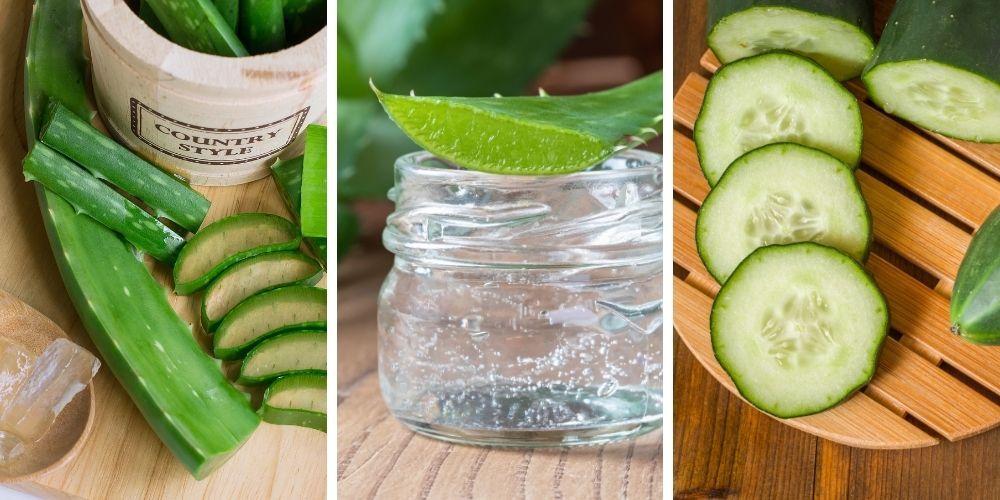
Ingredients:
- 1/2 cucumber
- 1 tablespoon Aloe Vera Gel
Instruction :
To make the mask, start by peeling the cucumber and cutting it into small pieces. Blend the cucumber pieces in a blender until it becomes a smooth paste. Add the Aloe Vera gel to the cucumber paste and mix well. Apply the mask to your face and leave it on for 15-20 minutes. Rinse off the mask with cool water and pat your face dry with a towel.

To use this mask, apply it to your face once or twice a week. It is important to do a patch test before applying the mask to your face to ensure that you are not allergic to any of the ingredients. You can also store the leftover mask in the refrigerator for up to a week.
Coconut Oil and Honey Face Mask (Combination Skin)
Coconut oil is a natural moisturizer that can hydrate the skin without clogging pores. It is also rich in fatty acids that can help repair the skin barrier and prevent moisture loss. Honey, on the other hand, is a natural humectant that can attract moisture to the skin, making it soft and supple. It also has anti-inflammatory and antibacterial properties that can help reduce acne and soothe irritated skin.

Ingredients:
- 1 tablespoon coconut oil
- 1 tablespoon honey
Instruction :
To make the mask, start by mixing the coconut oil (optional olive oil) and honey in a small bowl until it becomes a smooth paste. Apply the mask to your face, focusing on the areas that tend to be dry. Leave it on for 15-20 minutes. Rinse off the mask with warm water and pat your face dry with a towel.

To use this mask, apply it to your face once or twice a week. It is important to do a patch test before applying the mask to your face to ensure that you are not allergic to any of the ingredients. You can also store the leftover mask in a cool, dry place for up to a week.
Oatmeal and Milk Face Mask (Oily Skin)
Oatmeal is a natural exfoliator that can gently remove dead skin cells and unclog pores. It also contains anti-inflammatory properties that can help reduce redness and irritation on the skin. Milk, on the other hand, contains lactic acid that can help exfoliate the skin and reduce the appearance of pores. It also contains vitamins and minerals that can nourish and hydrate the skin.

Ingredients:
- 2 tablespoons oatmeal
- 2 tablespoons milk
Instruction :
To make the mask, start by blending the oatmeal in a blender until it becomes a fine powder. Mix the oatmeal powder with the milk in a small bowl until it becomes a paste. Apply the mask to your face, focusing on the areas that tend to be oily. Leave it on for 15-20 minutes. Rinse off the mask with warm water and pat your face dry with a towel.
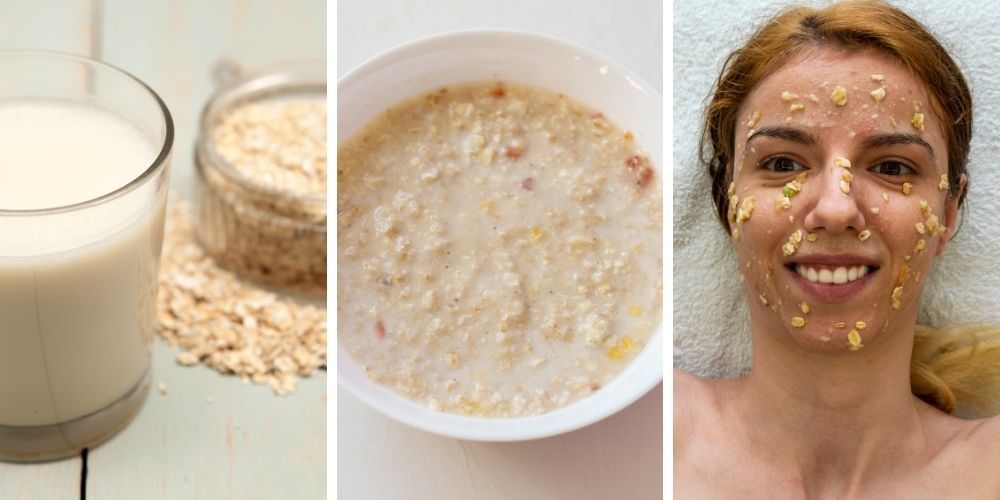
To use this mask, apply it to your face once or twice a week. It is important to do a patch test before applying the mask to your face to ensure that you are not allergic to any of the ingredients. You can also store the leftover mask in the refrigerator for up to a week.
Green Tea and Honey Face Mask (Acne-Prone Skin)
Green tea is known for its antioxidant and antibacterial properties that can help reduce inflammation and prevent acne. It also contains tannins that can help shrink pores and reduce oiliness on the skin. Honey, on the other hand, has antibacterial and anti-inflammatory properties that can help reduce acne and soothe irritated skin.

Ingredients:
- 1 green tea bag
- 1 tablespoon honey
Instruction :
To make the mask, start by brewing a cup of green tea using the green tea bag. Let it cool down for a few minutes before adding the honey to the tea. Mix well until it becomes a smooth paste. Apply the mask to your face, focusing on the areas that tend to be acne-prone. Leave it on for 15-20 minutes. Rinse off the mask with warm water and pat your face dry with a towel.

To use this mask, apply it to your face once or twice a week. It is important to do a patch test before applying the mask to your face to ensure that you are not allergic to any of the ingredients. You can also store the leftover mask in the refrigerator for up to a week.
Papaya and Egg White Face Mask (Dull Skin)
Papaya contains enzymes called papain that can exfoliate the skin and remove dead skin cells. It also contains vitamin C that can help brighten the skin and improve skin texture. Egg whites, on the other hand, contain protein that can help firm and tighten the skin. It also contains lysozyme that can help reduce the bacteria on the skin and prevent breakouts.

Ingredients:
- 1/2 cup mashed papaya
- 1 egg white
Instruction:
To make the mask, start by mashing the papaya in a small bowl until it becomes a smooth puree. Whisk the egg white in a separate bowl until it becomes frothy. Mix the papaya puree with the egg white until it becomes a smooth paste. Apply the mask to your face, focusing on the areas that tend to be dull. Leave it on for 15-20 minutes. Rinse off the mask with warm water and pat your face dry with a towel.
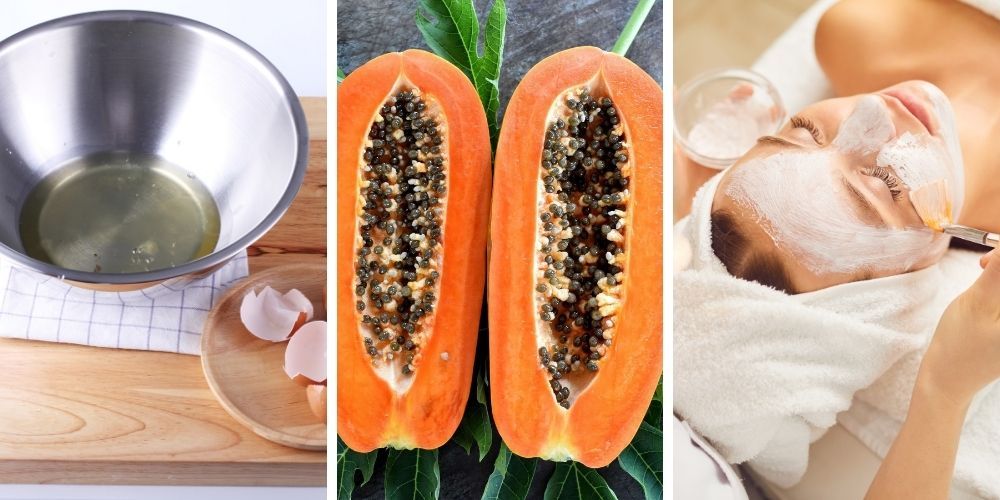
To use this mask, apply it to your face once or twice a week. It is important to do a patch test before applying the mask to your face to ensure that you are not allergic to any of the ingredients. You can also store the leftover mask in the refrigerator for up to a week.
Yogurt and Strawberry Face Mask (Large Pores)
Strawberries contain salicylic acid that can help exfoliate the skin and remove dead skin cells. It also contains vitamin C which can help brighten the skin and reduce inflammation. Yogurt, on the other hand, contains lactic acid that can help exfoliate the skin and reduce the appearance of pores. It also contains probiotics that can help soothe and hydrate the skin.

Ingredients:
- 4-5 strawberries
- 1 tablespoon yogurt
Instruction :
To make the mask, start by blending the strawberries in a blender until they become a smooth puree. Mix the strawberry puree with the yogurt in a small bowl until it becomes a smooth paste. Apply the mask to your face, focusing on the areas that tend to have large pores. Leave it on for 15-20 minutes. Rinse off the mask with warm water and pat your face dry with a towel.

To use this mask, apply it to your face once or twice a week. It is important to do a patch test before applying the mask to your face to ensure that you are not allergic to any of the ingredients. You can also store the leftover mask in the refrigerator for up to a week.
Cocoa Powder & Coffee Grounds Face Mask (Mature Skin)
Coffee grounds contain antioxidants that can help reduce the appearance of fine lines and wrinkles. It also contains caffeine that can help improve blood circulation and reduce puffiness. Cocoa powder, on the other hand, contains flavonoids that can help protect the skin from sun damage and improve skin hydration. Honey and coconut oil both have moisturizing and antibacterial properties that can help soothe and nourish the skin.
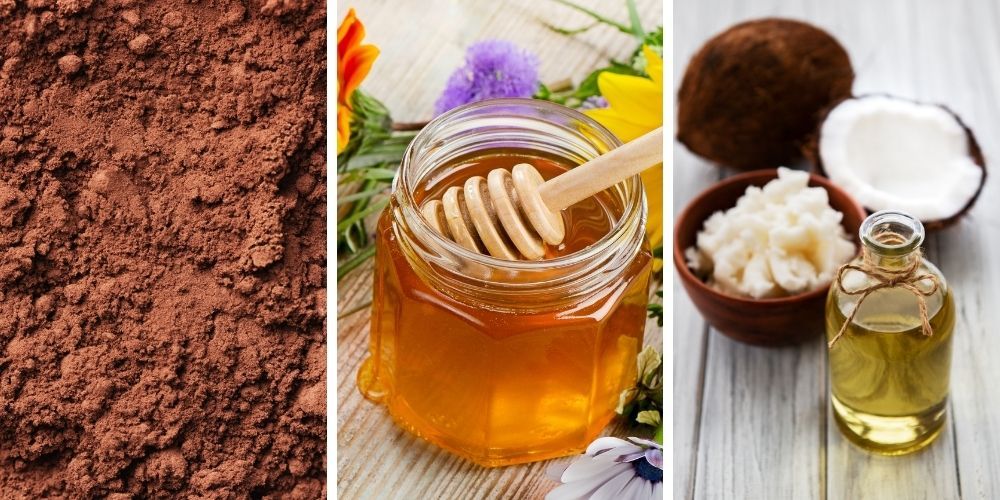
Ingredients:
- 2 tablespoons coffee grounds
- 1 tablespoon cocoa powder
- 1 tablespoon honey
- 1 tablespoon coconut oil
Instruction :
To make the mask, start by mixing the coffee grounds and cocoa powder in a small bowl. Add the honey and coconut oil to the mixture and stir until it becomes a smooth paste. Apply the mask to your face, focusing on the areas that tend to have fine lines and wrinkles. Leave it on for 15-20 minutes. Rinse off the mask with warm water and pat your face dry with a towel.

To use this mask, apply it to your face once or twice a week. It is important to do a patch test before applying the mask to your face to ensure that you are not allergic to any of the ingredients. You can also store the leftover mask in the refrigerator for up to a week.
Turmeric and Yogurt Face Mask (Hyperpigmentation)
Turmeric contains curcumin that can help brighten the skin and reduce the appearance of dark spots and hyperpigmentation. It also has anti-inflammatory properties that can help soothe and calm the skin. Yogurt, on the other hand, contains lactic acid that can help exfoliate the skin and reduce the appearance of dark spots. It also contains probiotics that can help balance the skin's natural microbiome.
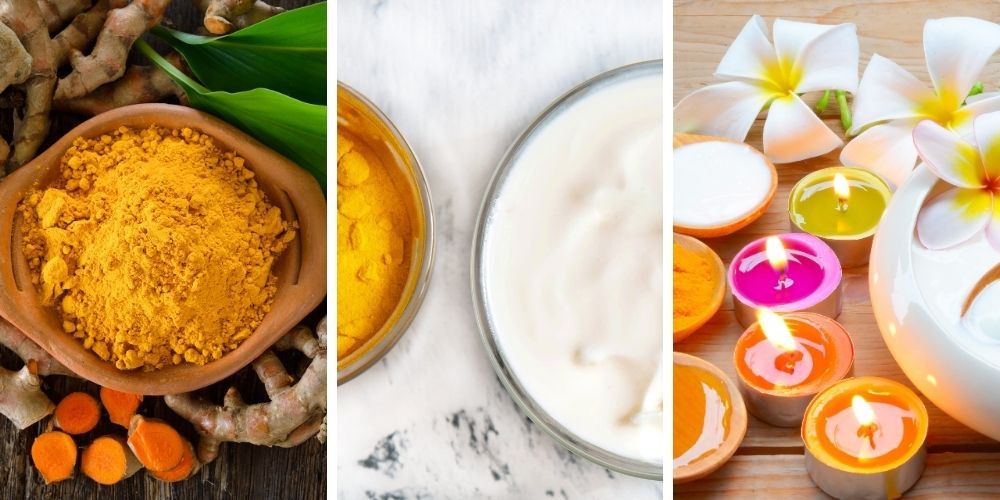
Ingredients:
- 1 teaspoon turmeric powder
- 1 tablespoon plain yogurt
Instruction :
To make the mask, start by mixing the turmeric powder and plain yogurt in a small bowl until it becomes a smooth paste. Apply the mask to your face, focusing on the areas that tend to have hyperpigmentation. Leave it on for 10-15 minutes. Rinse off the mask with warm water and pat your face dry with a towel. Be careful, turmeric can stain fabrics and surfaces, so make sure to avoid contact with clothing or countertops.

To use this mask, apply it to your face once or twice a week. It is important to do a patch test before applying the mask to your face to ensure that you are not allergic to any of the ingredients. You can also store the leftover mask in the refrigerator for up to a week. As turmeric has a strong yellow color, it can temporarily stain your skin. Don't worry, it will come off after a few washes.
Almond Oil and Chamomile Face Mask (Rosacea)
Chamomile tea contains anti-inflammatory and antioxidant compounds that can help calm and soothe the skin. It can also help reduce redness and irritation associated with rosacea. Almond oil, on the other hand, contains fatty acids that can help nourish and hydrate the skin. It also has anti-inflammatory properties that can help reduce redness and irritation.

Ingredients:
- 1 cup chamomile tea, cooled
- 1 tablespoon almond oil
Instruction:
To make the mask, start by brewing a cup of chamomile tea and let it cool. Add a tablespoon of almond oil to the tea and mix well. Apply the mixture to your face, focusing on the areas that tend to have rosacea. Leave it on for 10-15 minutes. Rinse off the mask with cool water and pat your face dry with a towel.

To use this mask, apply it to your face once or twice a week. It is important to do a patch test before applying the mask to your face to ensure that you are not allergic to any of the ingredients. You can also store the leftover mask in the refrigerator for up to a week.
Additionally, it's recommended to avoid triggers that can cause rosacea flare-ups, such as spicy foods, alcohol, hot beverages, and extreme temperatures. It's also important to use gentle, fragrance-free skincare products and to always wear sunscreen when going outdoors.
Charcoal and Bentonite Clay Face Mask (Detoxifying)
Activated charcoal powder has a porous surface that can attract and trap toxins, impurities, and excess oil from the skin. It can help unclog pores and make the skin look clearer and brighter. Bentonite clay, on the other hand, is a natural, absorbent clay that can help draw out toxins and impurities from the skin. It can also help control excess oil and improve the texture of the skin. Apple cider vinegar has antimicrobial properties that can help fight bacteria and prevent acne. Honey is a natural humectant that can help hydrate and soothe the skin. Tea tree oil is an antibacterial and anti-inflammatory oil that can help prevent and treat acne.

Ingredients:
- 1 tablespoon activated charcoal powder
- 1 tablespoon bentonite clay
- 1 teaspoon apple cider vinegar
- 1 teaspoon honey
- 1-2 drops of tea tree oil (optional)
- Water (as needed)
Instruction :
To make the mask, mix the activated charcoal powder and bentonite clay in a small bowl. Add the apple cider vinegar, honey, and tea tree oil (if using) to the mixture and stir well. Add water as needed to create a smooth paste. Apply the mask to your face, avoiding the eye area. Leave it on for 10-15 minutes or until it's completely dry. Rinse off the mask with warm water and pat your face dry with a towel.

To use this mask, apply it to your face once or twice a week. It is important to do a patch test before applying the mask to your face to ensure that you are not allergic to any of the ingredients. Avoid using this mask on sensitive or dry skin. You can also store the leftover mask in the refrigerator for up to a week.
The Benefits of Natural Ingredients in Skincare

Natural ingredients in skincare have been used for centuries to help nourish, protect, and enhance the skin's appearance. Here are some of the benefits of using natural ingredients in skincare:
Gentle and non-irritating
Natural ingredients are often gentler and less likely to cause skin irritation compared to synthetic ingredients. They are also less likely to clog pores and cause breakouts.
Nourishing and hydrating
Many natural ingredients, such as aloe vera, honey, and coconut oil, are rich in vitamins, minerals, and antioxidants that can help nourish and hydrate the skin. They can also help improve the skin's texture and reduce the appearance of fine lines and wrinkles.
Anti-inflammatory and soothing
Natural ingredients, such as chamomile, green tea, and oatmeal, have anti-inflammatory and soothing properties that can help reduce redness, inflammation, and irritation in the skin. They can also help calm sensitive skin and reduce the appearance of acne and rosacea.
Antimicrobial and antibacterial
Some natural ingredients, such as tea tree oil, lavender, and neem, have antimicrobial and antibacterial properties that can help fight bacteria and prevent acne.
Environmentally friendly
Natural ingredients are often more environmentally friendly compared to synthetic ingredients because they are biodegradable and do not contribute to pollution or harm wildlife.
Overall, natural ingredients in skincare can provide numerous benefits for the skin, from nourishing and hydrating to anti-inflammatory and antimicrobial. It's important to note that natural doesn't always mean better or safer, and it's still important to do a patch test and read labels carefully to ensure that the ingredients are safe and suitable for your skin type.
Final Thoughts
Creating a homemade face mask with natural ingredients can provide an effective way to hydrate and nourish the skin while also avoiding potentially harmful chemicals found in some commercial products. By using simple ingredients like lemon juice, pure aloe vera gel, and other natural substances, you can create a DIY face mask recipe that's easy to make and can help dissolve dead skin cells and rejuvenate your skin.
Applying a thin layer of your chosen face mask recipe can provide the necessary hydration and nourishment your skin needs to look and feel its best. So, whether you have oily skin, dry skin, or anything in between, consider trying out one of these 12 DIY hydrating face mask recipes to achieve a healthy, glowing complexion.
Other Posts You May Like
Enhance your natural glow by exploring our top 10 DIY face mist recipes for radiant skin, and discover the power of 18 refreshing homemade face toner recipes tailored to all skin types.


Don't forget to treat your body too with our curated list of homemade body wash recipes that you can easily try today – indulge in a complete self-care experience that's personalized and budget-friendly!

Please note that we are not medical professionals, and the information provided on this platform is for educational and informational purposes only. It is not intended to be a substitute for professional medical advice, diagnosis, or treatment. We recommend that you consult with a licensed healthcare provider or physician regarding any questions or concerns you may have regarding your health.











